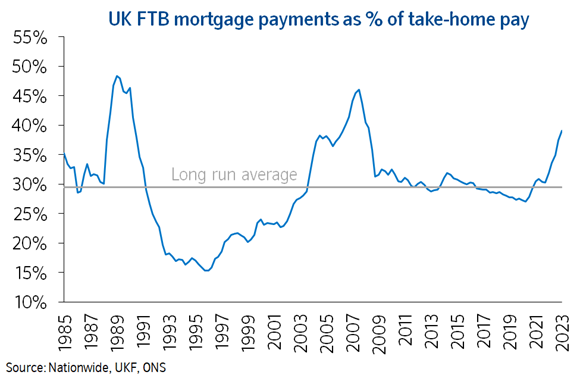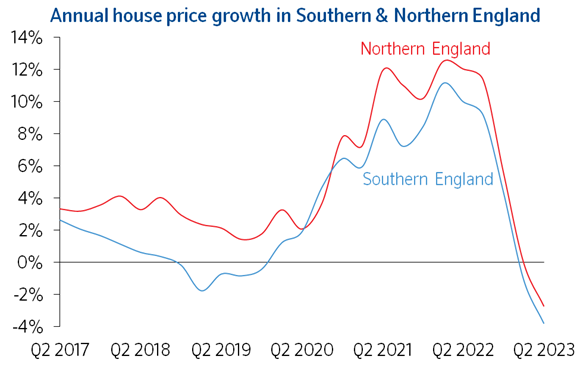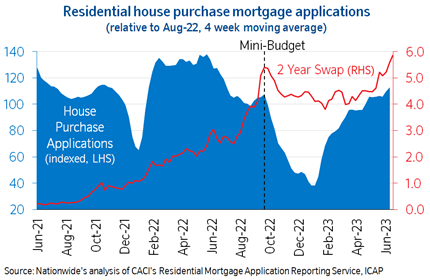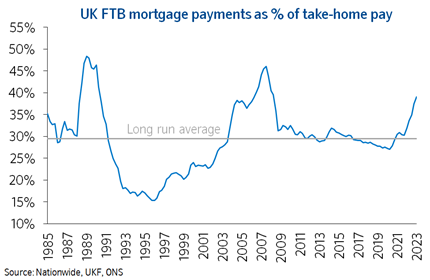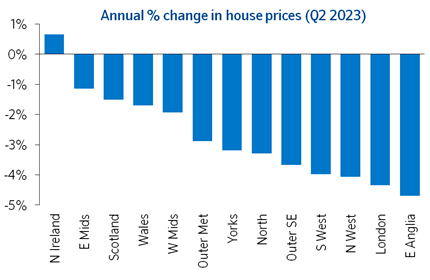|
Headlines |
Jun-23 |
May-23 |
|
Monthly Index* |
518.3 |
517.7 |
|
Monthly Change* |
0.1% |
-0.1% |
|
Annual Change |
-3.5% |
-3.4% |
|
Average Price (not seasonally adjusted) |
£262,239 |
£260,736 |
* Seasonally adjusted figure (note that monthly % changes are revised when seasonal adjustment factors are re-estimated)
Commenting on the figures, Robert Gardner, Nationwide's Chief Economist, said:
“Annual house price growth was broadly stable at -3.5% in June, little changed from the 3.4% decline recorded in May. Prices were also fairly stable over the month, rising by a modest 0.1%, after taking account of seasonal effects, reversing the 0.1% decline seen in May. (Note that June is typically the strongest month in terms of seasonal price rises hence the change in the unadjusted cash price is larger than 0.1% in the table above.)
“Longer term interest rates, which underpin mortgage pricing, have increased sharply in recent months, in response to data indicating that underlying inflation in the UK economy is not moderating as fast as expected. This has prompted investors to expect the Bank of England to increase its policy rate further and for it to remain higher for longer.
“Longer term borrowing costs have risen to levels similar to those prevailing in the wake of the mini-Budget last year, but this has yet to have the same negative impact on sentiment. For example, the number of mortgage applications has not yet declined (as illustrated in the chart below) and indicators of consumer confidence have continued to improve, though they remain below long run averages.
Higher interest rates impacting affordability
“The sharp increase in borrowing costs is likely to exert a significant drag on housing market activity in the near term. For example, for a representative first-time buyer earning the average wage and buying the typical property with a 20% deposit, mortgage payments as a share of take-home pay are now well above the long-run average, as illustrated in the chart below.
“Moreover, house prices remain high relative to earnings, and as a result, deposit requirements are still a significant barrier for those looking to enter the market. A 10% deposit on a typical first-time buyer home is equal to around 55% of gross annual income – this is down from the all-time highs of 59% prevailing in late 2022, but still marginally above the levels prevailing before the financial crisis struck in 2007/8.
“Moreover, despite the higher interest rates available to savers, the sharp rise in rents, together with continued high rates of inflation more generally is continuing to make it difficult for many prospective buyers to save for a deposit.
Is a soft landing still possible?
“Nevertheless, a relatively soft landing is still possible, providing the broader economy performs as we (and most other forecasters) expect.
“Labour market conditions are expected to remain relatively robust, with the unemployment rate remaining below 5%, while income growth is projected to remain solid. With Bank Rate likely to peak in the quarters ahead, longer term interest rates should also start to fall back.
“As a result, a combination of healthy rates of income growth and modest price declines should improve affordability over time, especially if mortgage rates moderate.
What about the impact of higher interest rates on those refinancing?
“Although 85% of the stock of outstanding mortgages are on fixed interest rates, around 400,000 borrowers are due to refinance each quarter in the years ahead as their deals come to an end. This equates to around 20% of the fixed rate mortgage stock refinancing by the end of 2023 and c.40% by the end of 2024.
“For those coming off two-year fixed rate deals, with mortgage rates approaching 6%, a new two-year deal is around 425bps higher than their existing rate, which equates to an increase of £385 per month for a typical borrower[1]. Those coming off five-year deals face an increase of 350bps on a new five-year fix (assuming a rate of 5.5%), which equates to an increase of c.£315 per month for a typical mortgage borrower.
“Clearly this represents a significant increase, but those borrowers were stress tested at interest rates above those now prevailing in the market to ensure they could cope with such an increase. Moreover, incomes have been rising at a solid pace in recent years. Lenders will also work with borrowers to provide assistance wherever possible.
“Therefore, providing the labour market and interest rates perform broadly as expected, we are unlikely to see the waves of forced selling which would probably be required to result in a more disorderly adjustment to the housing market.
All regions except Northern Ireland saw annual price falls
“Our regional house price indices are produced quarterly with data for Q2 (the three months to June) showing annual price declines in all regions, except Northern Ireland (see full table on page 4).
“Northern Ireland saw a modest 0.7% year-on-year price rise, making it the best performing region. Meanwhile, East Anglia was the weakest performing region, with prices down 4.7% compared with a year ago.
“All English regions saw a slowing in the annual rate of change compared with last quarter. London saw a 4.3% year-on-year decline, while the surrounding Outer Metropolitan region saw a 2.9% fall.
“Across northern England overall (which comprises North, North West, Yorkshire & The Humber, East Midlands and West Midlands), prices were down 2.7% compared with Q2 2022. The North West was the weakest performing northern region, with prices down 4.1% year-on-year. Meanwhile southern England (South West, Outer South East, Outer Metropolitan, London and East Anglia) saw a 3.8% decline.
“Scotland saw a slight improvement in the annual rate of change to -1.5%, from -3.1% last quarter. Meanwhile Wales saw a further slowing in annual house price growth from -0.7% to -1.7%.”



